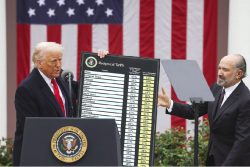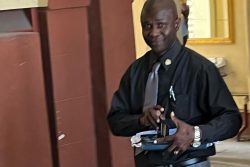This is the first of a lecture delivered by Professor Norman Girvan on February 20 at the UWI St. Augustine campus to launch the year of Sir Arthur Lewis in commemoration of the Caribbean’s first Nobel Laureate.
Professor Girvan’s presentation is reprinted from the Trinidad and Tobago Review of March 3, 2008. The second part will appear in our next issue.
By Norman Girvan
 The following distinguished lecture was delivered on February 20 at UWI, St Augustine to launch the Year of Sir Arthur Lewis in commemoration of the Caribbean’s first Nobel Laureate.
The following distinguished lecture was delivered on February 20 at UWI, St Augustine to launch the Year of Sir Arthur Lewis in commemoration of the Caribbean’s first Nobel Laureate.
One day in 1959, as I was preparing to enter the University (then College) of the West Indies, I picked up the newspaper and read a banner headline “Lewis to be new Head of the UCWI. Underneath was the picture of a man who balding, bespectacled, and unmistakably black. That may be no big thing in this day and age, but in 1959 the people who had headed this institution, who ran most of the academic departments, the people who were regarded as the natural repositories of academic accomplishment and administrative leadership, were people of another type. The impact of Lewis’s appointment as symbol of changing times can hardly be exaggerated— it would be as if, for instance, we were all to wake up on the morning of November 5, 2008 to hear that the newly elected President of the United States was Barack Obama.
There is a sense that Professor Arthur Lewis, as he then was, was living proof of the knowledge that ‘Yes, we can’. He had been a St Lucia Island scholar at age 17; he was the first West Indian to take First Class Honours at the London School of Economics, and a PhD in Industrial Economics at age 25. He was the first black member of the faculty of the L.S.E. and went on to become the first black Professor of economics at a British University. He went on to become the first black Nobel Laureate in Economics as well as the first West Indian Nobel Laureate in any field. Besides being the first West Indian Principal of the University College of the West Indies—and in that capacity he was instrumental in establishing St Augustine as the UCWI’s second campus—he was the first Vice Chancellor of the UWI; and the first President of the Caribbean Development Bank; and eventually recipient of 29 honorary degrees and of numerous other awards.
These are the milestones, but it is the scope and volume of the Sir Arthur’s scholarship over approximately half a century that one must find extraordinary, by any standard and in whatever age. At the time of his Nobel, Lewis acknowledged publication of ten books and about 80 other pieces; but a collection of his papers published in 1994 by SALISES, then the ISER, runs into three massive volumes, each about three inches thick, with a total of 109 items whose wide subject matter bear record to the reach of his mind and of his interests. Thus there are ten pa pers on industrial economics, twelve on world trade, eight on development planning, twelve on dual economies and five on agricultural economics. On the economics of particular regions in the developing world we find seven on Africa, two on Asia, and five on the Caribbean. Other categories reflect Sir Arthur’s engagement with the topical issues of his day or connected to his administrative work: there are six papers on the subject of race and economic development, six on education and three on politics.
At this point the editor, the late Dr Patrick Emmanuel, to whom we are all indebted for this Herculean effort, appears to have given up on further classification, for 25 items are placed into the category “other development issues” and another eight into a category known as, “various topics”. And all this done before the age of the personal computer and the internet, which have given contemporary researchers access to quantities of information and a capacity to process it that were undreamed of in Lewis’s time.
I hope to show, in this synoptic overview of Sir Arthur’s work, that he was not only a man of his time in the subjects that he chose to investigate and the answers he came up with; but also ahead of his time, in that much of his work has continuing salience and resonance in the world of today. (He was also, of course, ‘ahead’ of his time, by virtue of his intellectual brilliance and the many leadership positions that he occupied).
THE MAKING OF SIR ARTHUR
First, what do we know about the making of Arthur Lewis, the person; and Professor Lewis, the scholar? His own account of his career is characteristically concise and even self-deprecating. It is almost as if he would have us believe that his career was the result of a series of accidents. He says, “I became an economist when I really wanted to be an engineer, became a university teacher because there was nothing else for me to do, and became an applied economist because that was my mentor’s subject. The rest of the story continues in the same vein.”
Earlier, Lewis attributed his accelerated progress through school to the fact that as a child he went through a period of illness which kept him at home, and he was home schooled for a time by his own father. Of his meteoric rise through the ranks of British academia to be appointed Stanley Jevons Professor of Political Economy at Manchester University at the age of 33; he says, “My luck held, and I rose rapidly.”
Nonetheless, Lewis’s autobiographical statements show that he was very much a product of a dying colonial order, and was in turn a major intellectual contributor to the decolonisation process. He mentions, as one of his formative childhood experiences, his father taking him to a meeting of the local branch of the Marcus Garvey association, at the age of seven.
He is very clear that this was the origin of his anti-imperialism, which lead to his interest in the problems of underdevelopment, which in turn eventually lead to his Nobel. So Marcus Garvey definitely had hand in his winning in the prize! His mother, he says, always taught him that ‘anything the Europeans can do, we can do’; and also ‘to make the best of what we have’. She had been widowed with five sons, four of them minors, and brought them all up on a shoestring budget. These experiences fuelled not only his personal self-confidence, but also his later conviction, as a development econo¬mist, that poor countries could industrialise, no matter how slender their natural resources.
Arthur Lewis knew colonial racism at first hand, for the reason that he could not realise his ambition to become an engineer because of the colour bar to entry of the profession that the British Government imposed in its colonies (Lewis 1980: 2). After graduation, even as he made his academic name in the field of industrial economics, he was doing his own research on the West Indian peasantry and the West Indian labour movement, meeting with ‘fellow anti-imperialists from all over the world’, and meticulously researching the economic practices of the British colonial empire. At the end of the Second World War, after it became evident that the colonies would be granted independence, he lectured to colonial students who were preparing to go home to run their soon to be independent countries. Lewis challenged them: “forget about what the British did to you”, he said, “the point is, what will you do when you take power?” (I am paraphrasing here). Lewis regarded himself as an anti-imperialist; but his was not an anti-imperialism of bitterness or of hatred, but one of self-confidence and self-responsibility.
He was also influenced by the Fabian brand of socialism that predominated in the British Labour Party of the 1930s. One of his first publications, on Labour in the West Indies in the late 1930s, was a pamphlet published by the Fabian society that argued that labour had assumed the mantle of leadership of the West Indian national movement. This made Lewis essentially a social democrat and a believer in the mixed economy; but more eclectic than ideological in his approach to matters of public policy. He was quite comfortable in recognising the limitations of the free market and the necessity for public intervention in instances of market failure. He was, however, instinctively opposed to authoritarian rule, whether of the left or the right.
Methodologically, Lewis regarded himself as more of an applied economist and even economic historian, than as an economic theorist. As a young faculty member at the L.S.E. he says that most of his colleagues were “concerned with elaborating the theory, with turning words into diagrams and diagrams into equations (while) I was one of a minority engaged in testing the theories against the facts.” His approach to the teaching of development economics was policy-oriented and grounded in institutions, he spoke of the “…importance of recognising the sociological background, of political linkages”.
Now Lewis identified three main areas of his research. The first, industrial economics, was the subject of his doctoral thesis, and it is the least well known and probably least interesting branches of his work. The second, the history of the world economy since the middle of the 19th century and the third, problems of economic development; became intertwined; and it is here that he made his most significant contributions. I will seek to illustrate my theme by reference to three of his seminal publications.
INDUSTRIALISATION OF THE BRITISH WEST INDIES
The first of these is Industrialisation of the British West Indies, published in 1950, the work for which he is probably best known in this region. By way of background, I should say that Lewis had engaged in vigorous debate with the colonial authorities and with the British economist Benham, over the Moyne Commission Report and the Economic Plan for Jamaica. The article in question was the result of a stint with the Caribbean Commission, in which he studied Puerto Rico’s industrialisation policies and drew lessons for the British West Indies.
Lewis critiqued the prevailing economic orthodoxy, which held that the West Indies had a comparative advantage in the export of primary products, and should import manufactured goods. He argued that the overpopulation of the islands provided an economic rationale for an industrialisation strategy based on the export of labour intensive manufactures. But since capital and technology were short in the islands, foreign investors should be invited in to do the job. Foreign investors would also provide the distribution channels in overseas markets, as they had done in Puerto Rico. Lewis’s ingenious use of the Ricardian theory of comparative costs and his copious use of statistics to buttress his case demolished the arguments of his Colonial Office adversaries; and his recommendations became the basis of industrial development policies in the West Indies in the 1950s. The articles established his reputation in development economics and launched him on an illustrious international career as economic adviser in emerging countries in Africa and Asia.
THE DUAL ECONOMY MODEL
During this time, Lewis was troubled by a question that had been with him since his undergraduate days: why were prices in international trade always moving in favour of industrial goods, exported by the rich countries, and against primary products, exported by the poor? “The question”, he says, “was central to my life, since my home country was subject to violent swings in agricultural prices that played havoc with attempts to manage the economy with some stability.” There was also a historical question: why had real wages re¬mained constant in Britain during the first 50 years of the industrial revolution while profits and savings had increased?
The answer to both questions, he says, came to him one day in August 1952 while walking down a road in Bangkok. Assume that the supply of labour is not fixed, as in the neo-classical framework, but unlimited, due to population pressure (one suspects that he was surrounded by an army of vendors at the time). This “will keep wages down, pro¬ducing cheap coffee in the first case and high profits in the second case. The result is a dual (national or world) economy, where one part is a reservoir of cheap labour for the other.
 This flash of insight became the basis of Lewis’s celebrated ‘dual economy’ model of economic development with unlimited labour supplies; by which economic development takes place through the reinvestment of the surplus of the capitalist sector, which draws labour from the overpopulated subsistence sector at a constant real wage. When the economy is opened, the capitalist sector exports its produce to world markets at low relative prices because it is able to recruit cheap labour from the subsistence sector; and this will continue to happen as long as productivity in the subsistence sector remains low.
This flash of insight became the basis of Lewis’s celebrated ‘dual economy’ model of economic development with unlimited labour supplies; by which economic development takes place through the reinvestment of the surplus of the capitalist sector, which draws labour from the overpopulated subsistence sector at a constant real wage. When the economy is opened, the capitalist sector exports its produce to world markets at low relative prices because it is able to recruit cheap labour from the subsistence sector; and this will continue to happen as long as productivity in the subsistence sector remains low.
The model launched Lewis on a path that culminated with the Nobel, and figures prominently in the citation. According to one scholar, its appearance in 1954, “…created a sensation…it placed the emerging field of development economics squarely on the map of the economics profession, providing it with a set of bedrock working theorems… (that) set the field of development economics apart as a distinctive field of study.”
In the half century since its publication the model has been critiqued, defended, elaborated and refined (including by Lewis himself) and applied to a variety of situations in several books and numerous articles. In a review published in a special issue of the journal of the Manchester School to mark its 50th anniversary, two scholars conclude, “(its) continuing salience is a lasting testimony to the author’s extraordinary ability to combine theory and history into a coherent framework that can aid our understanding of the problems of underdevelopment.”
Sir Arthur’s own account is somewhat more succinct. Writing in 1979, he says that its publication in 1954 “was greeted equally with applause and with cries of outrage. In the succeeding 25 years other scholars have written five books and numerous articles arguing the merits of the thesis, assessing contradictory data, or applying it to solving other problems. The debate continues.”
But the model’s treatment of the problem of declining terms of trade between primary commodities and industrial goods continues to have salience today. For example, studies by UNCTAD show that the real prices of non-fuel primary commodities fell steadily from 1960 to the end of the 1990s; and hence ‘Between 1970 and 1997, the cumulative terms of trade losses for non-oil-exporting countries in Sub Saharan Africa amounted to 119 per cent of the regional GDP in 1997.”Only recently has the trend been arrested due to the rise in commodity prices resulting from demand from the rapidly growing Chinese economy.
But the problem is now being experienced by exports of labour-intensive manufactured goods from the developing economies. In other words the labour-intensive manufactures exported by developing countries have now taken on the same characteristics of their primary commodity exports. UNCTAD’s analysis attributes this to the unregulated employment conditions and the existence of surplus labour that prevail in many developing country exporters of these manufactures. Without going into details, the mechanism identified by UNCTAD is essentially the same as Lewis’s; that is the availability of cheap labour to the export sector due to low productivity per head in the traditional sector.
Indeed Lewis anticipated this development as early as 1978, when he wrote “…we must recognise that the opening up of the markets of the industrial countries to imports of light manufactures from the tropics is essentially of the same kind” (as the exports of tropical commodities) “it is an additional opportunity to sell low-wage labour” ( Lewis 1978: 244, emphasis added). In retrospect, this was a highly prescient comment.
THE AGRICULTURAL REVOLUTION
A second lesson that has continued relevance is the importance of effecting an agricultural revolution. By raising the productivity of domestic food production, the supply price of labour to the commodity sector would increase. This would counter the tendency for declining terms of trade; raise rural incomes, creating a market for the goods produced by the industrial sector and facilitating all-round improvements in living standards. Hence, Lewis regarded the agricultural revolution in developing countries as equally important to the industrial revolution. In his 1950 article on West Indian industrialisation he was at pains to point out that industrial and agricultural development in the region were not alternatives but had to proceed in tandem with one another. Unfortunately, governments in the Caribbean and in many parts of the developing world have often failed to appreciate this simple truth. Everywhere today we are seeing the results of decades of neglect of the domestic agricultural sector, in the form of rural poverty, rural-urban migration and the growth of urban mega-cities with the attendant social pathologies.
Lewis’s legacy calls on us to redress the imbalance by raising the return to agricultural activity, by making the conditions of rural life more attractive, by investing in human and physical capital for the agricultural sector and by providing the other kinds of government support needed.









